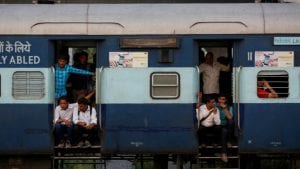Record passenger earnings put Indian Railways back on track
Summary
The Indian Railways (IR), world’s largest transporter, earned its highest ever passenger revenue despite effecting no fare hikes. It indicates that the IR has finally begun to reverse the trend of declining passenger numbers. The passenger revenue was up 5.1% to Rs 48,642.68 crore in 2017-18 against Rs 46,280.45 crore in the last fiscal. IR …
Continue reading “Record passenger earnings put Indian Railways back on track”
The Indian Railways (IR), world’s largest transporter, earned its highest ever passenger revenue despite effecting no fare hikes.
It indicates that the IR has finally begun to reverse the trend of declining passenger numbers.
The passenger revenue was up 5.1% to Rs 48,642.68 crore in 2017-18 against Rs 46,280.45 crore in the last fiscal.
IR carried 6.74 crore incremental passengers last fiscal.
In effect, the IR added around 185,000 incremental passengers daily on an average in 2017-18 versus the previous fiscal. It earned almost Rs 6.5 crore more on an average each day – without increasing fares – compared to 2016-17.

The gain in passenger numbers as well as total passenger earnings assumes significance since the trend in previous years has been an year-on-year decline.
FY18 was a year of consolidation and the IR regained its market share in the passenger segment, said Mohammad Jamshed, member (Traffic), railway board.
“Despite stiff competition from other modes of transportation, we were not only able to register positive growth but also surpass the target set for passengers booked in 2017-18,” he said.
According to Jamshed, the total number of passengers booked was 8,286.95 million, 0.82% higher than 8,219.51 million booked during the previous year.
“We have brought back more than 6.7 crore passengers to the Railways, which indicates that IR is the preferred mode of transport, ” he added.
According to IR, the per passenger kilometre cost is almost double the earning from each ticket.
It means ticket prices cover roughly only half the cost of each passenger km, and freight earnings continue to cross subsidise passengers, who have not seen an across-the-board fare hike in many years.
The average spend by the IR on per passenger km is 80 paise while the realisation through ticket earnings is only 41 paise.
This shows why the incremental earnings from the passenger business last fiscal also assume significance, when the IR anyway lost almost Rs 35,000 crore due to its public service obligations.
A NITI Ayog study showed that the IR has a 20% share of India’s total passenger traffic. It carries around 2.4 crore people daily across its network and lays claim to being almost two-and-a-half times the size of the Chinese rail network.
Targets vs Actuals
There has been a shortfall in the revenue earned from passengers (and freight) vis-à-vis respective targets during the last three years, said Rajen Gohain, MoS Railways.
Drop in originating passengers — both sub-urban and non-suburban — are the main reasons for fall in short of its target.
The MoS further added that even in 2017-18, till February, there was a persistent drop in non-suburban passengers.
In 2017-18, though the passenger earnings were the highest ever, they still fell behind the target the IR had set for itself.
In its revised estimates for the Union Budget, the IR had pegged total passenger earnings at Rs 50,125 crore, making the actual earnings a shortfall of about 2.98%.
Steps Taken to Increase Passenger Traffic
One of the biggest challenges the IR faces continuously is meeting growing demand on a capacity constrained network.
Introduction of new trains such as Tejas, Humsafar Express, Antyodaya Express addressed this problem to an extent. In the current fiscal, more such train will be added.
IR is also sweating the assets to improve utilisation, said Jamshed.
“We identified lie over periods of the coaching rakes at the terminals from the time table and used these lie over periods for introducing new trains and extending new ones…. as a result, we have already introduced 20 new trains and extended 44 trains using the lie over period. We plan to further introduce 40 more new services besides extending 56 more trains,” he said.
The Railways also ran multiple special train trips during festivals and vacations. In 2017-18, it operated 36,799 special train trips, which was 9% higher than 2016-17.
Initiatives for Reserved Segment
The IR has three broad categories of passenger traffic: Suburban, which comprises half of the total traffic; short distance non reserved traffic, which comprises another about 42% and the remaining 6-7% coming from the long distance reserved category.
It is the long distance reserved category, which accounts for maximum passenger revenues for the IR and this is where the focus was firmly fixed last fiscal.
The initiatives to woo long distance reserved passengers included increasing RAC (reservation against cancellation) births by 50%, offering a host of digital services such as waitlisting and enhancing the number of digital ticketing payment options.
The e-ticketing systems were upgraded in such a manner that frequency of ticket dispensing increased to 20,000 a minute from 7,000 tickets a minute earlier.
Sindhu Bhattacharya is a journalist based in Delhi.

Elon Musk forms several ‘X Holdings’ companies to fund potential Twitter buyout
3 Mins Read
Thursday’s filing dispelled some doubts, though Musk still has work to do. He and his advisers will spend the coming days vetting potential investors for the equity portion of his offer, according to people familiar with the matter









 Listen to the Article
Listen to the Article  Daily Newsletter
Daily Newsletter




